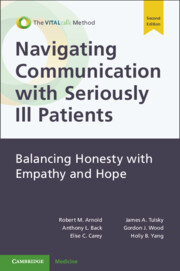Book contents
- Navigating Communication with Seriously Ill Patients
- Navigating Communication with Seriously Ill Patients
- Copyright page
- Dedication
- Reviews
- Contents
- Preface
- Acknowledgments
- 1 Taking Your Skills to the Next Level
- 2 Foundational Communication Skills
- 3 Talking about Serious News
- 4 Discussing Prognosis
- 5 Planning for the Future: Discussing What’s Important, Well Before a Crisis
- 6 Discussing Treatment Decisions
- 7 Between the Big Events
- 8 Goals of Care in Late-Stage Disease
- 9 Conducting a Family Conference
- 10 Dealing with Conflicts between Clinicians and Patients
- 11 Working Through Conflicts with Colleagues
- 12 When You’re Really Stuck
- 13 Talking about Dying
- 14 Cultivating Your Skills
- Index
- References
9 - Conducting a Family Conference
Reading the Room Under the Light of Group Dynamics
Published online by Cambridge University Press: 05 April 2024
- Navigating Communication with Seriously Ill Patients
- Navigating Communication with Seriously Ill Patients
- Copyright page
- Dedication
- Reviews
- Contents
- Preface
- Acknowledgments
- 1 Taking Your Skills to the Next Level
- 2 Foundational Communication Skills
- 3 Talking about Serious News
- 4 Discussing Prognosis
- 5 Planning for the Future: Discussing What’s Important, Well Before a Crisis
- 6 Discussing Treatment Decisions
- 7 Between the Big Events
- 8 Goals of Care in Late-Stage Disease
- 9 Conducting a Family Conference
- 10 Dealing with Conflicts between Clinicians and Patients
- 11 Working Through Conflicts with Colleagues
- 12 When You’re Really Stuck
- 13 Talking about Dying
- 14 Cultivating Your Skills
- Index
- References
Summary
Multiple family members means multiple perspectives, agendas, emotions, and values. And, families are more than a collection of individuals. They have with their own way of functioning as a whole. When meeting with family about their loved one’s care, there are important steps similar to the maps we used with patients themselves. First, pre-meet to decide who’s going to be invited. The team should also agree upon a big picture headline. During the conference, introduce all participants and the purpose of meeting. Assess what the family knows and their different perspectives. Update the family using a headline, and address questions and concerns. Empathize and respond to the various emotions in the room. Prioritize the patient’s values. Align with the patient’s values and support the family. Finally, summarize and provide a concrete follow-up plan. An effective family conference can get everyone on the same page, ensure that the patient and family understand the medical situation, and help the family and care team come together to make treatment decisions that align with the patient’s values.
- Type
- Chapter
- Information
- Navigating Communication with Seriously Ill PatientsBalancing Honesty with Empathy and Hope, pp. 136 - 154Publisher: Cambridge University PressPrint publication year: 2024

